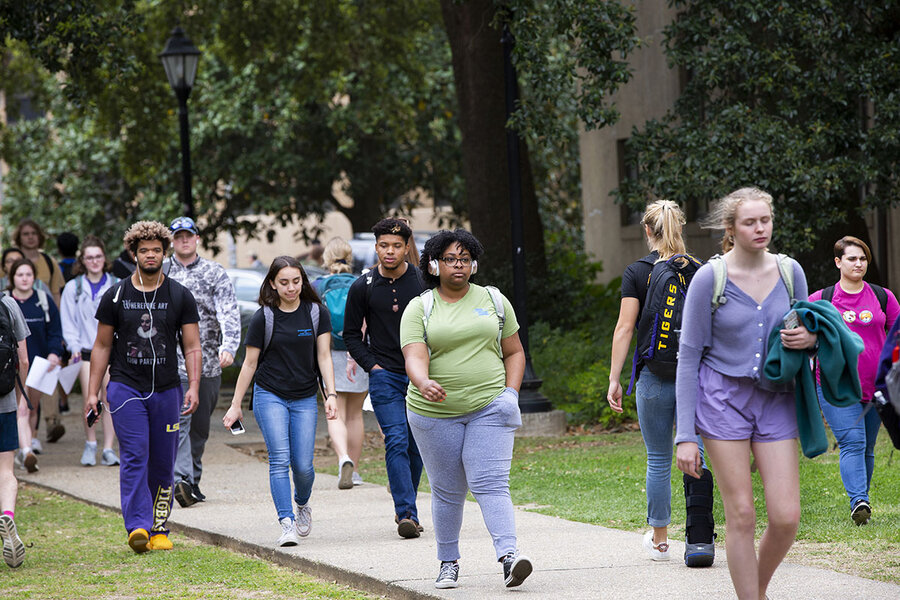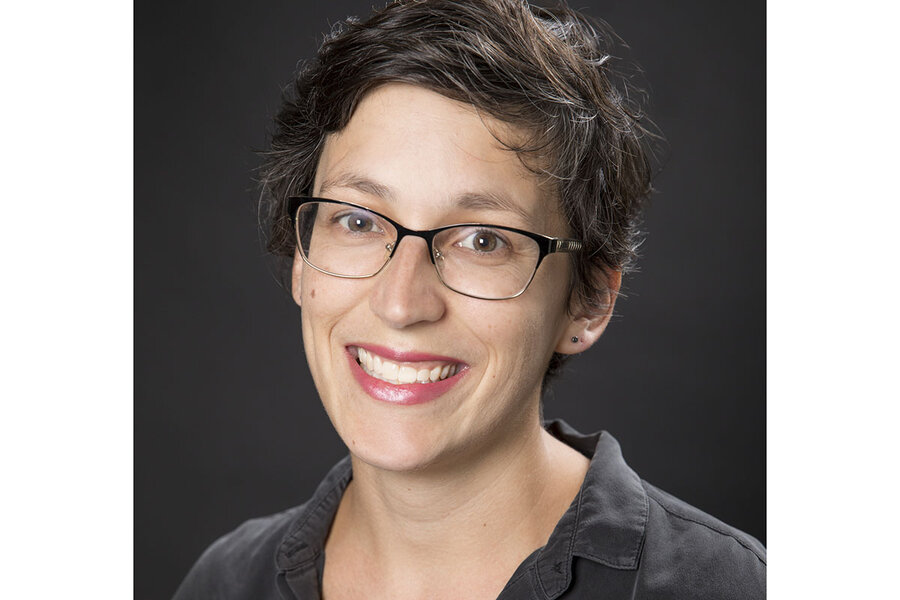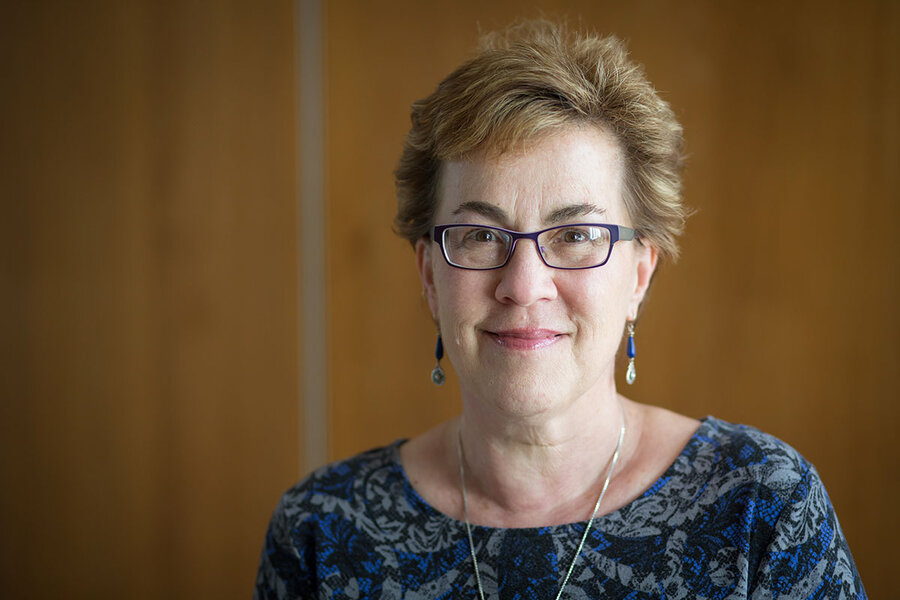College affordability, loan forgiveness, and a path to the future
Loading...
This summer, Dr. Richelle Brooks, a teacher and single mother, joined a group of 100 “debt strikers” who are refusing to repay their college loans in an effort to pressure President Joe Biden to forgive all outstanding federal student debt in his first 100 days in office.
The strike is symbolic – Mr. Biden has extended a pause on student loan payments through September – but it highlights a pressing issue in the United States.
Why We Wrote This
If Americans agree that college is the path to financial stability, what is the best way to help people afford to go?
As the nation’s federal student loan balance has mushroomed, topping $1.5 trillion last year, the calls to cancel some or all of that debt have grown louder. Proponents of loan forgiveness argue it has become an economic and social justice imperative.
If policymakers hope to rein in borrowing long term, they’ll need to find new ways to help students pay for college. That might include making college free or expanding the federal Pell Grant program to cover more students or a larger share of tuition.
“If you cancel debt without tackling the system holistically,” says Wil Del Pilar, a vice president at The Education Trust, “all you’re doing is setting yourself up to have the same problem in 10 to 15 years.”
This story was supported by a grant from the Solutions Journalism Network.
Richelle Brooks knew that college was the surest path to the middle class, but her mother, a restaurant manager, couldn’t afford it. So the high school senior did what counselors and teachers told her to do – she took on loans, confident she’d earn enough to pay them back.
When she didn’t, she borrowed again … and again. After 13 years in school, she had a doctorate in educational leadership – and more than $200,000 in debt.
But economic security has eluded her. For awhile, she worked as a principal at a charter school. But when that school shut down last summer, she couldn’t find another administrative post and had to settle for a lower-paying teaching job.
Why We Wrote This
If Americans agree that college is the path to financial stability, what is the best way to help people afford to go?
Now 33, with two children she’s raising on her own and a balance that has ballooned to $237,000, Dr. Brooks feels she was misled.
“I did everything I was told you have to do to make a livable wage,” she says. “You take out loans, and when you graduate you pay them back.”
So this summer, she joined a group of 100 “debt strikers” who are refusing to repay their loans in an effort to pressure President Joe Biden to forgive all outstanding federal student debt in his first 100 days in office. The strike is symbolic – Mr. Biden has extended a pause on student loan payments through September – but its message is clear.
“This debt isn’t going to be repaid,” says Thomas Gokey, a onetime college adjunct who co-founded the Debt Collective, the group behind the strike. “It has to be canceled.”
As the nation’s federal student loan balance has mushroomed, topping $1.5 trillion last year, the calls to cancel some or all of that debt have grown louder. Total cancellation, an idea considered fringe just a few years ago, has become mainstream, with more than half of Americans in a 2019 poll saying they are in favor of eliminating all existing student loan debt.
Now, amid a pandemic that has led to disproportionate job losses among people of color and a racial justice movement that has focused attention on inequities across American society, proponents of loan forgiveness argue it has become an economic and social justice imperative.
“The student loan system is predatory, and it’s violent against already marginalized groups,” says Dr. Brooks.
Canceling student loans would shrink the racial wealth gap and stimulate the economy, freeing up money that consumers would spend on homes, cars, and new businesses, proponents argue.
But skeptics say debt relief would do neither thing well, and would be unfair to Americans who worked their way through college, chose the cheaper institution, or sacrificed to pay down their debt – never mind those who sat out college altogether. It would deliver a windfall to higher-income households, while leaving out some of the poorest Americans – those with only high school diplomas – thereby deepening the nation’s educational divide.
President Biden has signaled he won’t wipe out student loans unilaterally, and called on Congress to cancel $10,000 per borrower through legislation instead.
But nearly everyone agrees on one thing: Debt relief wouldn’t do anything to stem the spiraling cost of college or reduce future students’ reliance on loans. It could even make those problems worse, if students start borrowing without regard to their ability to pay, and colleges raise their prices accordingly.
If policymakers hope to rein in borrowing long term, they’ll need to find new ways to help students pay for college. That might include making college free to everyone – or everyone below an income cutoff – or expanding the federal Pell Grant program to cover more students or a larger share of tuition.
None of the options are cheap, and they’d have to clear a closely divided Congress.
Yet there’s a burgeoning consensus among activists and lawmakers from both political parties that the nation’s college financing system is in dire need of comprehensive reform.
“If you cancel debt without tackling the system holistically, all you’re doing is setting yourself up to have the same problem in 10 to 15 years,” says Wil Del Pilar, vice president of higher education policy and practice at The Education Trust.
Debt relief and its limitations
There’s no doubt that Black borrowers are disproportionately burdened by student loans, borrowing more and defaulting more often, than their white peers. Black student parents, like Dr. Brooks, borrow the most of all, according to the Institute for Women’s Policy Research.
These disparities have their roots in decades of housing and labor market discrimination that have made it difficult for Black families to accumulate wealth. The median white household now has a net worth 10 times that of the median Black household – a gap that has been perpetuated, and made wider still, by unequal student debt burdens. More than half of Black households with student debt have zero or negative net worth.
What’s less clear is whether forgiveness would be the best way to level the economic playing field.
A recent study found that forgiving $50,000 in student debt, as progressive lawmakers have proposed, would wipe out debt for nearly three quarters of Black households, lifting more than half of those with negative net worth into positive territory.
But that same study found that debt relief wouldn’t come close to closing the wealth chasm between Black and white households.
Other research shows that debt relief would deliver the biggest benefit to high-income households, which often include individuals who borrowed to attend graduate school. If the government canceled all student debt, the top 20% of earners would get $192 billion in savings, and the bottom 20% would get only $29 billion.
A smarter solution, some skeptics say, would be to expand income-based repayment programs that let struggling borrowers lower their monthly payments to a manageable amount and have their remaining balance forgiven after 20 to 25 years.
“The principle that you don’t pay more than you can afford makes sense,” says Sandy Baum, nonresident senior fellow at the Urban Institute’s Center on Education Data and Policy. “Let’s forgive the debt of people who can’t afford it, not those who can.”
Proponents of debt relief say the focus on dollars forgiven is misplaced. They point out that even if upper-income households would get the biggest share of the relief, poorer ones would benefit more, in relative terms, since they’re starting out with less. Just a few thousand dollars in forgiveness would slash their debt-to-income ratios and multiply their wealth.
“It’s disingenuous to say we shouldn’t help tens of millions of people who are struggling because of a fear that some people would benefit more,” says Louise Seamster, an assistant professor of sociology and African American studies at the University of Iowa.
Loan forgiveness would also help Americans with some college and no degree – a group that made up more than a quarter of unemployed people last fall. These “noncompleters” are three times more likely to default on their student loans than college graduates.
Yet when it comes to shoring up the economy, debt relief would be far less stimulative than unemployment benefits and universal checks. Abolishing all $1.5 trillion in federal student loan debt would free up only $90 billion in cash in 2021, according to the Committee for a Responsible Federal Budget.
That’s partly because a relatively small share of the savings would go to low-income individuals, who research shows are the most likely to spend additional money when they get it.
It’s also because debt relief, unlike stimulus payments, doesn’t accrue to individuals all at once. Borrowers aren’t handed a check for the forgiven amount; they simply stop making payments on their debt. For a typical borrower in standard repayment, complete cancellation would free up between $200 and $300 a month.
And debt relief wouldn’t reduce future borrowing, either.
Free college
To ease the burden of student debt long term, policymakers will need to find a way to bend the cost curve or shift more of the responsibility for paying for college back onto taxpayers.
President Biden has proposed doubling the maximum Pell Grant award and creating a federal-state partnership that would make community college tuition-free for all students and four-year public institutions tuition-free for households earning less than $125,000.
The president’s “free college” plan would increase the number of students enrolled in college by 2 million. And by creating a better educated workforce, it would grow Americans’ disposable income by $61 billion a year, boosting gross domestic product by $139 billion in the first two years alone, a recent analysis by the Campaign for Free College Tuition found. It would drive up graduation rates, increasing state and federal income tax revenue in the long term.
The plan would also discourage states from slashing their higher education budgets during economic downturns, requiring them to maintain their spending to qualify for a federal match. State budget cuts have contributed to rising tuitions, with colleges raising their prices to recover the shortfall.
Though several cities and localities and more than a dozen states already offer “free college,” only one state – New York – covers four-year colleges, and it excludes part-time students.
A federal program would provide the “scale and scope” that state and local programs can’t, says Morley Winograd, president of the Campaign for Free College Tuition. The group’s polling shows that roughly three-quarters of Americans support some form of free college.
But there’s no guarantee that states would buy into free college, even if the feds cover the bulk of the costs, as President Biden has proposed. When Congress offered states a 90% match to expand Medicaid under the Affordable Care Act, a number of Republican-led states rejected the deal. A decade after the law was enacted, 39 states had expanded, while 12 states had not.
“It’s not free college for all; it’s free college in states with Democratic governors that decide to participate,” says Matthew Chingos, vice president for education data and policy at the Urban Institute.
Others warn that educational quality could suffer if states stretch their budgets to make college free, and don’t invest in instruction and student services when enrollments spike.
Regardless of the merits of free college, the president’s plan is likely to face pushback from conservatives concerned about its cost. That’s why Michelle Miller-Adams, a professor of political science at Grand Valley State University in Allendale, Michigan, suggests starting with free community college – an idea that has found support in several red states, including Tennessee, and has the backing of the business community, a key Republican constituency.
“If you can get free two-year college, and demonstrate its benefits, you can build from there,” she says.
A recent study of 33 free public college programs from across the country found that they increased enrollment among first-time, full-time students, with the biggest boost occurring among Black, Hispanic, and female students.
Yet even the two-year plan would suffer from one of the same flaws as debt relief: It would offer help to some higher-income people who don’t really need it, says Phillip Levine, an economics professor at Wellesley College in Massachusetts who studies student aid.
Doubling down on the Pell Grant
A more targeted approach would be to double the Pell Grant, sending more money to students with the greatest need, Dr. Levine says. The grant’s purchasing power has eroded over time, and now covers less than a third of the cost of attending a public four-year college.
Doubling the Pell Grant would completely close the affordability gap for low-income students, an analysis by Dr. Levine found.
Another way the Pell program could be used to drive down debt would be to make students in short-term programs eligible for the grants. That idea has bipartisan support in Congress and is popular with the public, but it’s controversial.
Skeptics worry that extending Pell to short-term programs would lead to an increased “tracking” of low-income students of color into highly specialized careers with limited potential for growth. Others fear an explosion of low-quality programs seeking to profit off the federal dime.
Proponents counter that safeguards can be put in place to ensure program quality, and say short-term programs should be seen not as an end point, but as the first rung on a ladder leading to a degree.
“At a time when millions are out of work, extending Pell to short-term programs would put people on a path to get quickly back into the job market,” says Amy Ellen Duke-Benfield, a senior fellow with the National Skills Coalition. “And it won’t require them to take on debt.”
The evidence for short-term programs is mixed. Though some studies have found wage gains for students in some states, others have shown that 2 in 5 adults with only a short-term certificate are unemployed. A recent federal pilot found that extending Pell Grants to students in short-term programs increased enrollment and completion rates, but had no impact on borrowing.
The reality, of course, is that none of these plans may come to pass. As the nation emerges from a pandemic and a recession, there will be a lot of urgent needs and limited resources to meet them, says Jessica Thompson, associate vice president at The Institute for College Access & Success.
But Dr. Brooks and the other 99 debt strikers say they aren’t giving up on their fight for full debt relief, despite Mr. Biden’s rejection of the idea.
“Nothing will happen unless we fight like our lives depend on it,” says Mr. Gokey, the Debt Collective co-founder. “And our lives do depend on it.”
This story was supported by a grant from the Solutions Journalism Network, a nonprofit organization dedicated to reporting about responses to social problems.










